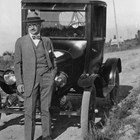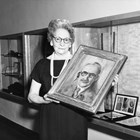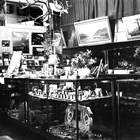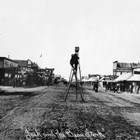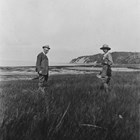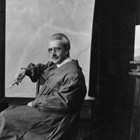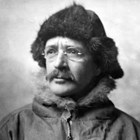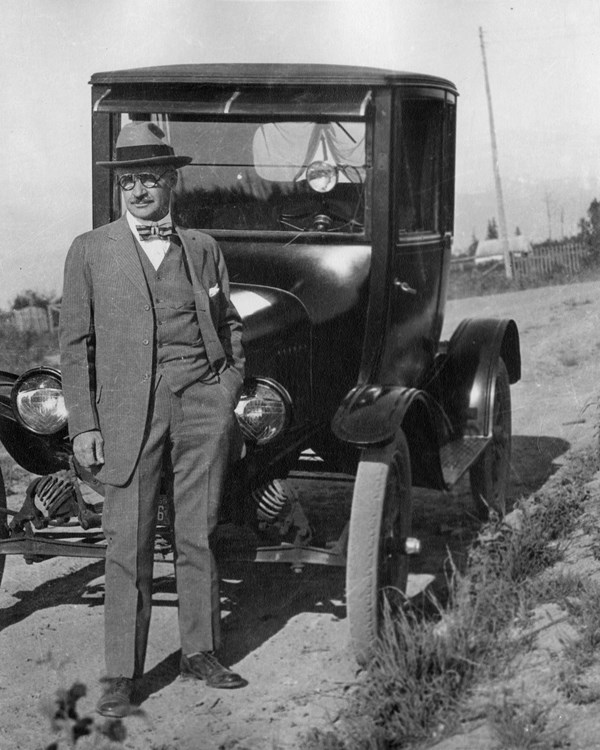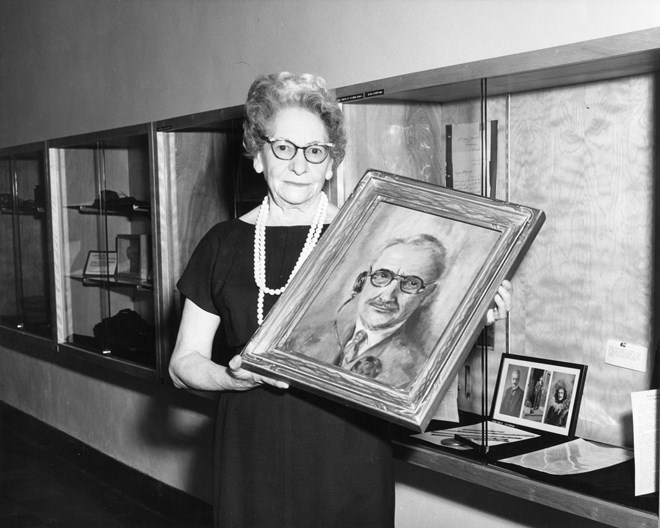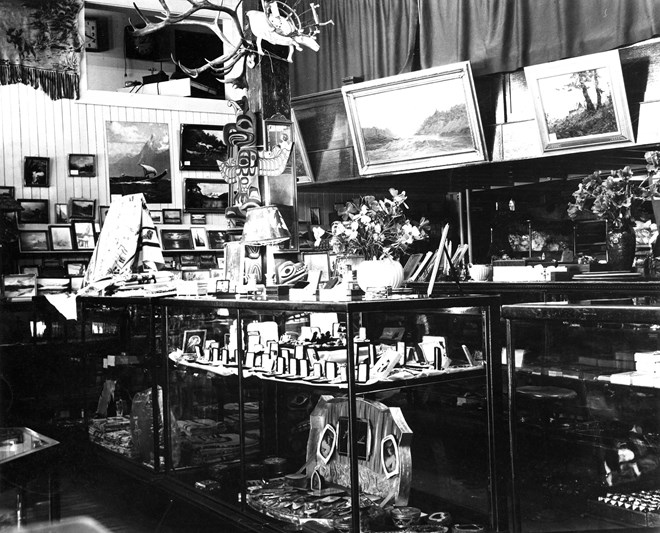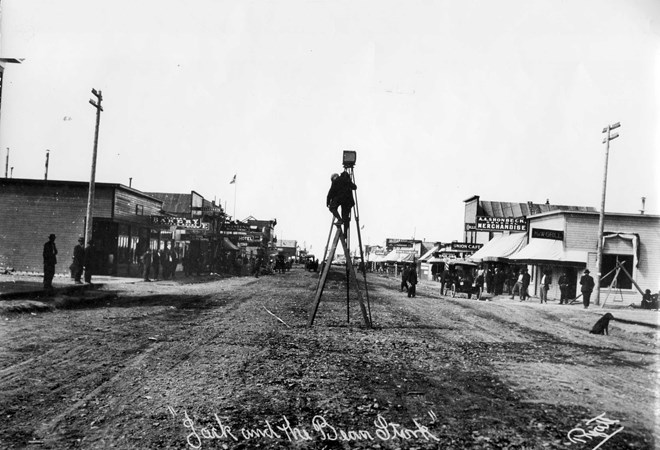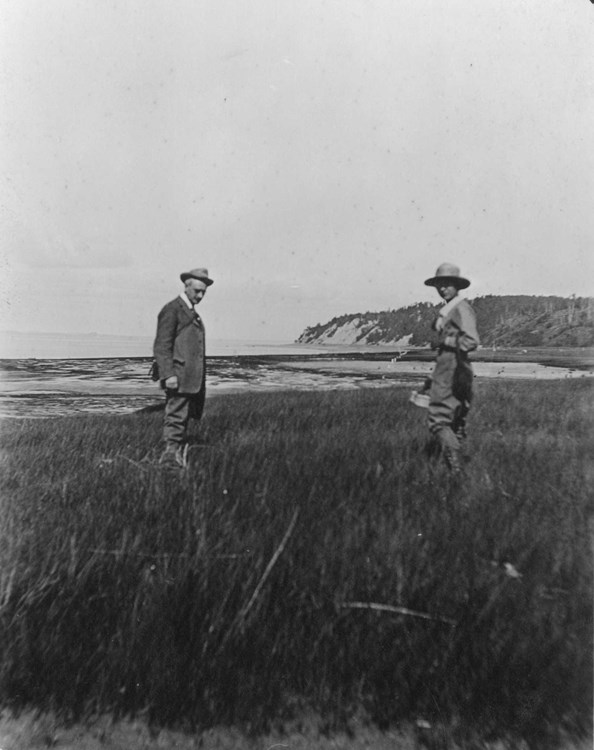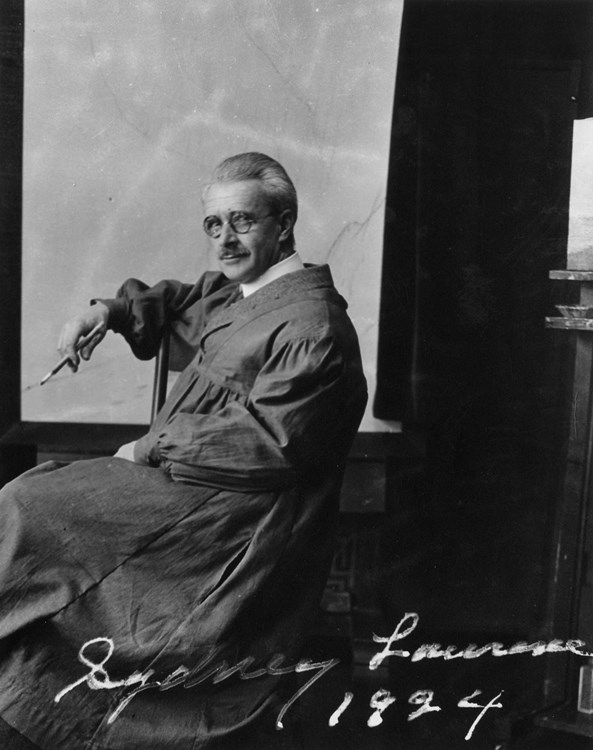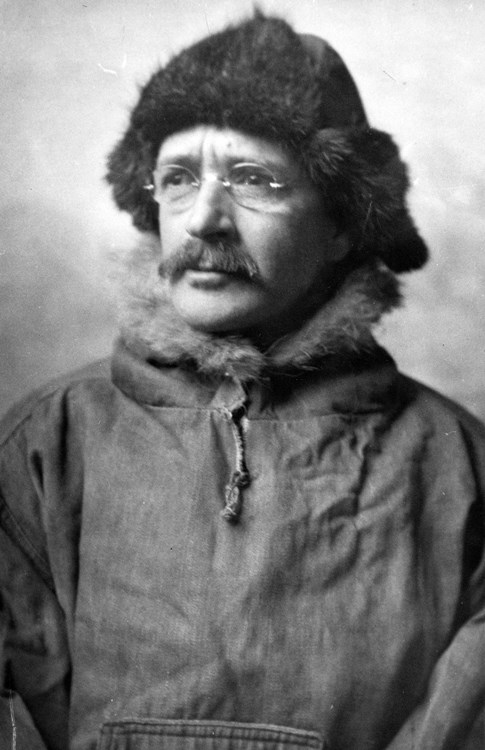Laurence, Sydney
1865-1940 | Artist, Photographer, and Prospector
After his death, Sydney Laurence became internationally famous as “the foremost painter of Alaskan scenes” during the first three decades of the twentieth century. He painted Alaskan landscapes of “romantic and unspoiled Alaska” on such subjects as Mount McKinley (now Denali), rustic cabins and caches, oceans crashing on rocky coasts, and other dramatic scenes. He made his home in Anchorage for twenty-five years from 1915 to 1940. Laurence is best known for his paintings of Mount McKinley in many moods. In Anchorage, examples of his work are on public display at the Anchorage Museum; Wells Fargo Bank’s Alaska Heritage Museum and Library; and at Z.J. Loussac Library, Anchorage Public Library.1
Early Years
Sydney Mortimer Laurence was born in Brooklyn, New York on October 14, 1865, to Edward Z. and Katherine Marris Leefe Laurence. Edward Laurence was an officer in the Union army during the American Civil War, and after the war worked in New York City, first in “wines” and later as a “broker.”2
According to Laurence’s biographer, art historian Kesler Woodward, a number of accounts indicate that Laurence attended the Peekskill Military Academy in Peekskill, New York, between 1870 and 1885. There are assertions that Laurence studied art with the maritime painter Edward Moran, brother of Thomas Moran. There are numerous colorful, conflicting, and uncorroborated accounts of “running away at sea” at the age of sixteen or seventeen for a period of from one to four years. By 1887 he was painting in New York City, and in 1888 and 1889 had work exhibited at the National Academy of Design in New York City.3
On May 18, 1889 Laurence married Alexandrina Dupre, a fellow artist in New York City. Several noted artists, including Thomas Moran, and instructors at the Art Students League of New York attended his wedding. The couple, less than a week later, sailed for England to pass the summer on the scenic coast at St. Ives, Cornwall. Their stay at St. Ives, a fishing village and art colony, extended for nearly fifteen years.
In 1894, Laurence became a member of the Salmagundi Club in New York City, which included among its members several artists who were considered “tonalists,” a term for a new style of American painting which flourished from about 1880 to 1915; it was largely forgotten until the 1970s. Tonalism was a personal, more intimate style of landscape painting which encompassed “a particular attitude toward subject matter, color, and light.” Some of the features of Tonalism painting were the prevalence of a single color to which all others are subordinated; landscape through a visible atmosphere or mist; and lively brushwork and glazing to reach the final, desired “tone.”4 Kesler Woodward believes that Laurence became associated with this style of American painting. Laurence continued to live in England, becoming a member of the Royal Society of British Artists and exhibiting in England and at the Paris Salon.
Laurence was also an illustrator-correspondent for several publications, including the British magazine Black and White starting in 1895, and, possibly, for the New York Herald during the Spanish-American War. In a 1934 interview for the Seattle Sunday Times, Laurence gave a colorful account of being clubbed over the head by a Zulu warrior while covering the Matebele Zulu Wars in South Africa in 1894, which resulted in the loss of hearing in his left ear. In 1900, he was promoted to special war artist by Black and White magazine and continued as an artist in the Boer War and the Boxer Rebellion and also began work as a professional photographer.5
Alaska Years as Gold Prospector and Painter
Laurence’s work with Black and White magazine continued until 1903, when he apparently left London for Alaska to search for gold, abandoning his wife and two sons, Leslie, age eight and Eugene, age one. He arrived first in Juneau and obtained temporary work as a photographer. Hearing of gold discoveries in Cook Inlet, he prospected there and in the surrounding area. He left for Valdez sometime in 1904, prospecting for gold and working odd jobs in the winter. In November and December 1904, Alexandrina and their two sons sent several Christmas photograph postcards, addressed to Laurence at “Tyoonok (sic), Alaska”, and were the last known communications between him and his family. Laurence’s movements during his early years in Alaska are difficult to follow.
Laurence painted pictures of the Tyonek area while he stayed with Durrell Finch, the representative of the Alaska Commercial Company. The Anchorage Museum has a 1905 painting by Laurence, “Tyonek, Alaska,” which is dedicated to Finch.6 In 1906, Laurence acted as Finch’s agent for a mining claim on Ramsdyke Creek. He also filed several mining claims in the Talkeetna recording district in his own name.
By 1909, Laurence was at various times in Cordova, Seldovia and Seward. He painted “Cordova Bay” (1909), a 14-foot panorama, which is in the Whatcom Museum in Bellingham, Washington.7 Nellie Brown, a close friend of Laurence, stated that he worked with photographer E.A. Hegg in Cordova in 1907 or 1908. Laurence painted the bay from a nearby mountaintop, on commission from Hegg, who employed him to hand-tint photographs for a brief period.8 Hegg made other small artistic efforts that had a pivotal effect on Laurence’s life by reawakening his neglected talent.9 In the 1910 U.S. Census, he is listed as living in Beluga, married twenty years, and his occupation given as “mining.”10 In 1911 he was perhaps in Tacoma, Washington, as there are several paintings signed “1911, Tacoma.” In 1912, he painted in Seldovia and beach mined near Ninilchik on the Kenai Peninsula.
Early in 1913, Laurence was grubstaked with $400 in gold and a letter of credit by a group in Valdez to paint Mount McKinley for exhibit at the Panama Pacific Exposition in San Francisco. He camped south of the mountain during the summer, returning to Valdez in the fall, and through the fall and early winter painted a 6-foot x 12-foot view of Mount McKinley. The painting, “Top of the Continent” (1914),11 was accessioned into the National Collection of Fine Arts (now the National Museum of American Art) of the Smithsonian Institution in 1915. The piece remained in the custody of the Smithsonian Institution for more than fifty years, but it was later removed from the collection and has passed into private hands.12 Laurence’s views of Mount McKinley were extremely popular both with locals and wealthy visitors and it became his signature image.
Anchorage Years (1915-1940)
In 1915, Laurence moved from Valdez to Anchorage, where he worked as a laborer on the Alaska Railroad, gold miner, and photographer, taking portraits at his photographic company in the Carrol Building on Fourth and E Streets.13 The following year he moved his office to the Harmony Theatre. While not mining in the Cache Creek area near Talkeetna, Laurence lived at the new Anchorage Hotel, operated by Mr. and Mrs. Frank I. Reed. In 1919, he began to sell his paintings at Belle Simpson’s Nugget Shop, a well-known gift shop in Juneau. By 1920, he opened a studio in the Anchorage Hotel. By 1922 his paintings become more popular, and he closed his photography studio to pursue full-time painting. He continued to prospect, now for oil as well as gold in the Talkeetna recording district.
Laurence built up a reputation for his landscape and marine art, which was popular among Alaska residents as well as visitors. By 1923, he had been recognized as Alaska’s most prominent painter. President Warren G. Harding purchased one of Laurence’s paintings when he visited Alaska to open the Alaska Railroad. When Austin E. “Cap” Lathrop, a Fairbanks businessman, made the silent film melodrama, the Chechahcos (1923), Laurence painted the decorative borders for the subtitles and a series of six large landscapes that were used as transition frames in the film.14 The art that he produced for the film introduced his work beyond Alaska, and he opened a second studio in Los Angeles in 1924. For the remainder of his life, Laurence spent his winters in California and summers in Anchorage. Laurence began to produce paintings for Carl Block of Peoria, Illinois, to be sold in Block’s department store throughout the 1930s.15
In 1928, Laurence married a young French painter, Jeanne Kunath Holeman, in Los Angeles.16 Jeanne joined Laurence in Anchorage in the summers and Los Angeles and Seattle during the colder months. In 1931 he had an exhibit at the Ebell Salon in Los Angeles, listed as his first exhibit in thirty years. He also had a slight stroke that affected his coordination and painting style later that year. In 1933 he gave up the studio in Los Angeles, although he continued to travel between Los Angeles, Seattle, and Alaska.
Sydney Mortimer Laurence died in Anchorage on September 11, 1940 after suffering a stroke. According to the Anchorage Daily Times, he had astonished his wife and friends the day before by announcing that he was going to die. The Times reported: “When he went to the barber shop during the afternoon he told friends that he was ‘getting prettied up to die’. He had a haircut and a shave. When he was through, he turned to a mirror, quirked his face, saluted his image and said, ‘Goodbye, old boy’.”
Laurence entered the hospital at 5:00 p.m. and ate a “hearty dinner.” He was in good spirits when friends visited him that evening. When his wife, Jeanne, bid him good night he said: “It’s goodbye this time. I won’t be here tomorrow.”17 Laurence was buried in the Anchorage Memorial Park Cemetery. Jeanne Laurence died in Anchorage on August 13, 1980.18
Legacy
Alaska residents, particularly those in Anchorage, hold Laurence in great esteem, considering him a great artist with a national and international reputation. Kesler Woodward commented on the “extraordinary, almost mythic status Laurence enjoys in Alaska.” Woodward considers Laurence the “foremost historical painter of the Alaskan landscape.” In Woodward’s Sydney Laurence, Painter of the North (1990), he remarks, “At the same time, it is a sign of the continuing geographical and cultural remoteness of this northern state that the name of the painter and his work are little known outside of Alaska. Virtually every Alaska resident of a year or more knows Laurence’s name.”19
In Sydney Laurence, His Life and Work (1982), Robert Shalkop, former director of the Anchorage Museum, stated that the earliest known exhibition of Laurence’s work was A Retrospective Exhibit of Paintings by Sydney Laurence. This exhibit was organized by the Cook Inlet Historical Society in 1957 and was on display on March 23-24 of that year in the Anchorage Municipal Auditorium. The show featured twenty-three paintings from local collections, and the public response was such that the hall was renamed the Sydney Laurence Auditorium. In 1975, the Anchorage Historical and Fine Arts Museum presented a major exhibition, Sydney Laurence, an Alaskan Impressionist to celebrate the opening of a new wing to the original museum building.20 In 1985, the Alaska Center for the Performing Arts opened at 621 West Sixth Avenue. The Sydney Laurence Theater, one of the Center’s three theaters, was constructed within the walls of the theatre named for him that previously stood on the site.21 In 1999, the world premiere of Syd, a stage portrait of Sydney Laurence, was performed by the Eccentric Theatre Company at Cyrano’s Playhouse in Anchorage, with Jerry Harper as the famous painter.22 Until recently, the Anchorage Museum had a gallery devoted solely to his work, and many of his paintings can be found on display there. Besides oils and watercolors, the Anchorage Museum’s collection of his work includes photographs and pencil and ink sketches. Laurence’s paintings can also be found at the University of Alaska Museum of the North in Fairbanks, Alaska State Museum in Juneau, other museums, and in private collections.
The most authoritative source on Laurence is the catalog for an Anchorage Museum retrospective exhibit in honor of the fiftieth anniversary of Laurence’s death in 1990, written by Kesler E. Woodward, Sydney Laurence, Painter of the North. Woodward acknowledges the great contribution of Sue Burrus who was principal biographical researcher for the Emmy award-winning public television documentary, Laurence of Alaska, which was produced by KAKM-TV (Alaska Public Television) in Anchorage in 1990. Also valuable is Jeanne Kunath Laurence’s account of her life with Sydney Laurence in My Life with Sydney Laurence (1974).
Endnotes
- Kesler E. Woodward, Sydney Laurence, Painter of the North (Seattle: University of Washington Press in association with the Anchorage Museum of History and Art, 1990), xi; and Rae Arno, Anchorage Place Names: The Who and Why of Streets, Parks, and Places (Anchorage: Todd Communications), 2008), 46.
- Edward Laurence, 1880 U.S. Census, New York City, New York, ED 586, page 495C, National Archives Microfilm Publication T9, Tenth Census of the United States, 1880, Roll 895, 1880 United States Federal Census [database on-line), http://ancestry.com (accessed October 19, 2014).
- Kesler E. Woodward, Sydney Laurence, Painter of the North, 123; Robert L. Shalkop, Sydney Laurence, His Life and Work: The Collection of the Anchorage Historical and Fine Arts Museum (Anchorage: Anchorage Historical and Fine Arts Museum, Municipality of Anchorage, 1982), 4; and Elizabeth Tower, Anchorage: From Its Humble Origins as a Railroad Construction Camp (Fairbanks: Epicenter Press,1999), 58-59.
- Kesler E. Woodward, Sydney Laurence, Painter of the North, 5-9.
- Kesler E. Woodward, Sydney Laurence, Painter of the North, 124-125; and Typescript, “Sydney Laurence,” Bagoy Family Pioneer Files (2004.11), Box 5, Atwood Resource Center, Anchorage Museum at Rasmuson Center, Anchorage, AK.
- See plate no. 14, “Tyonek, Alaska,” 1905 (cat. no. 14), oil on canvas over board, 23 ½ x 10, Kesler E. Woodward, Sydney Laurence, Painter of the North, 40.
- See plate no. 16, “Cordova Bay,” 1909 (cat. no. 16), oil on canvas, 35 x 191, Kesler E. Woodward, Sydney Laurence, Painter of the North, 42-43.
- Mary J. Barry, Jack and Nellie Brown: Pioneer Settlers of Anchorage, Alaska (Anchorage: M. J. Barry, 2000), 54-55; and Deloria Tarzan Ament, “Sydney Laurence: Northern Exposures from a Brooklyn Boy,” Seattle Times, September 30, 1990, http://community.seattletimes.nwsource.com/archive/?date=19900930&slug=1095909 (accessed January 31, 2015).
- Mary J. Barry, Jack and Nellie Brown: Pioneer Settlers of Anchorage, Alaska, 54-55.
- Kesler E. Woodward, Sydney Laurence, Painter of the North, 125.
- See photograph, “Top of the Continent,” 1914, oil on canvas, 71 x 95, Private Collection, Philadelphia, Pennsylvania (photograph courtesy of National Collection of Fine Arts, Smithsonian Institution (illustrated in color in Arts and Connoisseur, June 1968), in Robert L. Shalkop, Sydney Laurence (1865-1940), an Alaskan Impressionist: [exhibition] February 28-March 30, 1975 (Anchorage: Anchorage Historical and Fine Arts Museum, 1975), 6.
- Robert L. Shalkop, Sydney Laurence, His Life and Work, 10; and Robert L. Shalkop, Sydney Laurence (1865-1940), an Alaskan Impressionist: [exhibition] February 28-March 30, 1975 (Anchorage: Anchorage Historical and Fine Arts Museum, 1975), 7-8.
- Rae Arno, Anchorage Place Names: The Who and Why of Streets, Parks, and Places, 46; and Claus-M. Naske and Ludwig J. Rowinski, Anchorage: A Pictorial History (Virginia Beach, VA: Donning Company, 1981), 115.
- Kesler E. Woodward, Sydney Laurence, Painter of the North, 127; Robert L. Shalkop, Sydney Laurence, His Life and Work, 10-11; and Elizabeth A. Tower, Alaska’s First Homegrown Millionaire: Life and Times of Cap Lathrop (Anchorage: Publication Consultants, 2006), 58-59.
- Elizabeth A. Tower, Anchorage: From Its Humble Origins as a Railroad Construction Camp, 59.
- The marriage certificate listed Sydney Laurence as a widower and Jeanne Kunath Holeman as divorced. See Kesler E. Woodward, Sydney Laurence, Painter of the North, 127; and Elizabeth A. Tower, Anchorage: From Its Humble Origins as a Railroad Construction Camp, 59.
- “Sydney Laurence Dies,” Anchorage Daily Times, September 12, 1940, 1.
- “Wildflower Artist Jeanne Laurence Dies at 93,” Anchorage Times, August 13, 1980, A-1.
- Kesler E. Woodward, Sydney Laurence, Painter of the North, xi.
- Robert L. Shalkop, Sydney Laurence, His Life and Work, 3; and Kesler E. Woodward, Sydney Laurence, Painter of the North, xii. Shalkop is also the author of the exhibit catalog, Sydney Laurence (1865-1940), an Alaskan Impressionist: [exhibition] February 28-March 30, 1975 (Anchorage: Anchorage Historical and Fine Arts Museum, 1975).
- Alison K. Hoagland, Buildings of Alaska (New York: Oxford University Press, 1993), 87.
- Program notes, Syd, Eccentric Theatre Company, Cyrano’s Playhouse, Anchorage, Alaska, in File: Sydney Laurence, Bagoy Family Pioneer Files (2004.11), Box 5, Atwood Research Center, Anchorage Museum at Rasmuson Center, Anchorage, AK.
Sources
This entry for Sydney Laurence originally appeared in John P. Bagoy, Legends & Legacies, Anchorage, 1910-1935 (Anchorage: Publications Consultants, 2001), 106-108. See also the Sydney Laurence file, Bagoy Pioneer Family Files (2004.11), Box 5, Atwood Resource Center, Anchorage Museum at Rasmuson Center, Anchorage, AK. Note: edited, revised, and substantially expanded by Bruce Parham, January 31, 2015.
Preferred citation: Bruce Parham and Walter Van Horn, “Laurence, Sydney,” Cook Inlet Historical Society, Legends & Legacies, 1910-1940, http://www.alaskahistory.org.
Major support for Legends & Legacies, Anchorage, 1910-1940, provided by: Anchorage Museum at Rasmuson Center, Atwood Foundation, Cook Inlet Historical Society, and the Rasmuson Foundation. This educational resource is provided by the Cook Inlet Historical Society, a 501 (c) (3) tax-exempt association. Contact us at the Cook Inlet Historical Society, by mail at Cook Inlet Historical Society, Anchorage Museum at Rasmuson Center, 625 C Street, Anchorage, AK 99501 or through the Cook Inlet Historical Society website, www.cookinlethistory.org.
